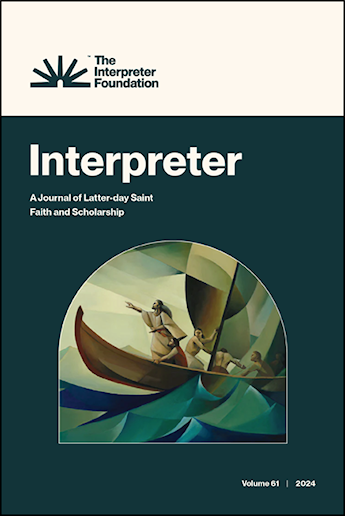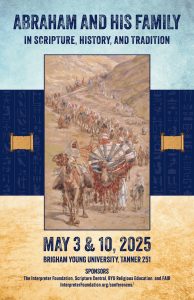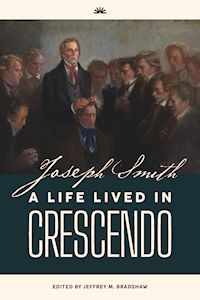[Editor’s Note: We are pleased to present chapter 5 from a book entitled Anachronisms: Accidental Evidence in Book of Mormon Criticisms. It is presented in serialized form in this volume of Interpreter: A Journal of Latter-day Saint Faith and Scholarship.]
 Welcome to Interpreter: A Journal of Latter-day Saint Faith and Scholarship, the peer-reviewed journal of The Interpreter Foundation, a nonprofit, independent, educational organization focused on the scriptures of The Church of Jesus Christ of Latter-day Saints. Non-print versions of our journal are available free of charge, with our goal to increase understanding of scripture. Our latest papers can be found below.
Welcome to Interpreter: A Journal of Latter-day Saint Faith and Scholarship, the peer-reviewed journal of The Interpreter Foundation, a nonprofit, independent, educational organization focused on the scriptures of The Church of Jesus Christ of Latter-day Saints. Non-print versions of our journal are available free of charge, with our goal to increase understanding of scripture. Our latest papers can be found below.
Interpreter's Mission Statement →
Read the journal →
Learn more about the Board →
Find out how you can donate →
Contact the Editorial Board →
|
Abraham and His Family In Scripture, History, and Tradition Saturday, May 3, 2025 Sponsored by For more information, go to https://interpreterfoundation.org/conferences/2025-abraham-and-his-family-conference/ |
|
Edited by Jeffrey M. Bradshaw Available Now This two-volume set (1100 pages total) seeks to enrich study of the life and teachings of Joseph Smith through essays by knowledgeable and faithful scholars on selected punctuation marks of Joseph Smith’s final years in Nauvoo. While some of Joseph Smith’s contemporaries saw these events and doctrinal developments as evidence that he was a fallen prophet, modern Latter-day Saints, looking back, see them as a glorious culmination to a faithful life. Go to https://interpreterfoundation.org/books/ for more information |
Anachronisms: Accidental Evidence in Book of Mormon Criticisms
The Bands of Death, the Chains of Hell, and the Seed Motif
Abstract: This article continues a discussion of the imagery, words, and phrases that make up a specific leitmotif, called the seed motif. Two instances of the seed motif found in Alma are discussed as a seemingly intentional diptych in which one narrative reflects the other, but in the negative. Five specific examples from the motif are examined in greater detail, with a look at their origin and usage throughout the record. The narrative of Abinadi is presented as a unique iteration of the seed motif wherein the concept of the bands of death is introduced. The paper concludes by discussing the relationship between authorship of the Book of Mormon, the seed motif, and the metaphor of the bands of death and the chains of hell.
Anachronisms: Accidental Evidence in Book of Mormon Criticisms
Chapter 4
Ancient Culture
[Editor’s Note: We are pleased to present chapter 4 from a book entitled Anachronisms: Accidental Evidence in Book of Mormon Criticisms. It is presented in serialized form in this volume of Interpreter: A Journal of Latter-day Saint Faith and Scholarship.]
Latter-day Saint Theology and the Problem of Evil
Abstract: The classical formulation of God as the sole, self-existent Being and ground of all that exists poses a philosophical problem. If God is omniscient and omnipotent, why does evil exist? Why does he not save humankind from moral and natural evil? If we embrace the full set of classical assumptions of creedal Christianity, these questions have no satisfactory answer and God cannot be absolved of responsibility for evil. This paper reviews and rejects several classical and modern philosophical formulations that try to solve the problem of evil. It then argues that the problem of evil dissolves if we accept Restoration theology in its most compelling form. Pluralism replaces monism, law is largely natural rather than legislated, and the necessity of atonement is located in humanity rather than in God, though God graciously provides the Atonement of Jesus Christ, which makes human exaltation possible.
Anachronisms: Accidental Evidence in Book of Mormon Criticisms
Chapter 3
Metals and Metallurgy
[Editor’s Note: We are pleased to present chapter 3 from a book entitled Anachronisms: Accidental Evidence in Book of Mormon Criticisms. It is presented in serialized form in this volume of Interpreter: A Journal of Latter-day Saint Faith and Scholarship.]
Joseph Smith Jr. as a Translator: The Book of Abraham as a Case Study
Abstract: This paper examines Joseph Smith’s approach to translation, using the Book of Abraham as a case study to explore the interplay between divine revelation and human participation in scriptural production. While the Book of Abraham incorporates both ancient and modern elements, its unique synthesis resists simple categorization as either an unblemished Abrahamic autograph or a purely nineteenth-century pseudepigraphon. Drawing on historical evidence and textual analysis, this paper aims to illuminate Joseph Smith’s role as both translator and revelator, offering insights into how Latter-day Saints might understand the complex process of producing sacred texts.
Anachronisms: Accidental Evidence in Book of Mormon Criticisms
Chapter 2
Warfare in the Book of Mormon
[Editor’s Note: We are pleased to present chapter 2 from a book entitled Anachronisms: Accidental Evidence in Book of Mormon Criticisms. It is presented in serialized form in this volume of Interpreter: A Journal of Latter-day Saint Faith and Scholarship.]
Chiasmus in the Book of Jarom
Abstract: Jarom strongly evidences the use of chiasmus to structure his short book. This paper seeks to uncover, display, and discuss the chiastic patterning of the book and hopefully suggests an enhanced understanding of the hidden beauty and deep meaning of this brief but important text. The book of Jarom indeed offers more than what may otherwise be revealed by only a cursory reading of its fifteen verses. Awareness of the chiastic pattern of the text reinforces an understanding of Jarom’s important message.
Anachronisms: Accidental Evidence in Book of Mormon Criticisms
Chapter 1
Book of Mormon Animals
[Editor’s Note: We are pleased to present chapter 1 from a book entitled Anachronisms: Accidental Evidence in Book of Mormon Criticisms. It is presented in serialized form in this volume of Interpreter: A Journal of Latter-day Saint Faith and Scholarship.]
Anachronisms: Accidental Evidence in Book of Mormon Criticisms
Introduction
[Editor’s Note: We are pleased to present the Introduction from a book entitled Anachronisms: Accidental Evidence in Book of Mormon Criticisms. It is presented in serialized form in this volume of Interpreter: A Journal of Latter-day Saint Faith and Scholarship.]
A Fitting Tribute to the Prophet of the Restoration
Review of Jeffrey M. Bradshaw, ed., Joseph Smith: A Life Lived in Crescendo, 2 vols. (Orem, UT: The Interpreter Foundation; Salt Lake City: Eborn Books, 2024). 1,101 pgs., $24.95 per vol. (softback), $69.95 per vol. (hardback).
Abstract: Joseph Smith: A Life Lived in Crescendo is one of the most extensive and ambitious scholarly works on the founder of The Church of Jesus Christ of Latter-day Saints. Its twenty-one essays address various issues relating to the culmination of the Prophet’s ministry. They provide diverse and profound insights worthy of examination by serious students of the latter-day Restoration.
Jeremiah “the Prophet”
Abstract: This article, which focuses on the role of Jeremiah as a prophet, is based on a study of the Hebrew Bible and the Greek Septuagint. It also analyzes references to Jeremiah in the Book of Mormon and connects those references to current scholarly research on the book of Jeremiah. Consistent with the general consensus among biblical scholars today, as well as Nephi1’s own references to Jeremiah in the Book of Mormon, the author proposes that even though Jeremiah embodied the office of a prophet, he was not recognized as being “among the prophets” during his lifetime. This is a subtle yet significant difference. If this view is correct, it would further substantiate the alignment between the Book of Mormon and contemporary scholarly perspectives on the historical reception of Jeremiah’s identity as a prophet in antiquity.
Easter as Threshold: Trauma, Transformation, and God’s Presence in Liminal Spaces
Abstract: Using the context of Easter, this personal essay explores perceptions of God’s presence and absence during human suffering. There is a theological thread that ties Christ’s suffering for our griefs and sorrows during his Atonement directly to his ability to succor us as we enter into despair due to our own trauma. Our suffering occurs during moments of transition and vulnerability known as “liminal spaces.” It is in these moments that the Savior meets us at the threshold, helping us move through trauma toward transformation in Christ. Our ability to move forward openly in liminal spaces will help us to recognize God’s presence in these moments as well as to discern the reflection of his presence in those who minister to us in our grief.
Spiritual Implications of the Timing of the Death of Jesus Christ
Abstract: Centuries-long speculation continues regarding the circumstances surrounding the death of the Savior. Whether he died sooner than would have been expected, as some scholars believe, or lived longer than expected, statements from the scriptures and modern-day prophets indicate that the Lord died at the exact moment of his choice. According to the Gospels and historical accounts, that moment coincided with the sacrifice of the later of the two daily tamid sacrifices. The tamid had been instituted by Jehovah and symbolized the future atoning sacrifice of the Savior. Each of the other offerings throughout the sacrificial day between the two tamid sacrifices symbolized other qualities of the Lord. The proximity of his death to the Passover suggests an additional association between the two. Ritual prayers offered as the final tamid was being offered coincide further with the missions of the Savior. Jesus Christ chose the moment of his death to synchronize with these events as he symbolically fulfilled the ancient law of sacrifice.
The Covenant Path of the Ancient Temple in 2 Nephi 31:19–20
Abstract: In this article, I discuss how the ancient analogue to what President Nelson has called “the covenant path” might be seen in the Book of Mormon and elsewhere in scripture not so much as a journey of covenant-keeping that takes us to the temple but as a journey that takes us through the temple. Throughout the Book of Mormon, observant readers will find not only the general outline of the doctrine of Christ but also corresponding details about the covenant path as represented in temple layout and furnishings. Nowhere is this truth better illustrated than in 2 Nephi 31:19–20 where Nephi summarizes the sequence of priesthood ordinances that prepare disciples to enter God’s presence. In doing so, he masterfully weaves in related imagery—guiding readers on an end-to-end tour of the temple while reminding them of the three cardinal virtues of faith, hope, and charity. The doctrinal richness of these two verses is a compelling demonstration of the value of President Nelson’s encouragement to study the biblical context of modern temples as a source of enlightenment about the meaning of the ordinances. This essay also suggests that the foundational elements of Latter-day Saint temple rites are ancient and were given to Joseph Smith very early in his ministry as he translated the Book of Mormon. It is hoped that a closer look at the beautiful imagery in 2 Nephi 31 will provide profitable reflection for readers.
Through a Glass Darkly: Was There a Twentieth-Century Corruption of 1 Corinthians 13:12?
Abstract: This paper considers the well-known account of Paul having been struck blind on the road to Damascus and his equally well-known statement that “for now we see through a glass darkly.” Both are examined in light of a solar eclipse that occurred across the Mediterranean in AD 49. It is possible that Paul could have been referring to an experience of viewing the solar eclipse through a filter. The article provides an exploration of potential astronomical aids that may have been available to first-century viewers of the eclipse. Views of solar phenomenon are shown and then Jewish and Christian thoughts are discussed regarding glass, crystals, clouds, and the veil. At the end of the nineteenth century, a conflict arose among commentators about whether 1 Corinthians 13:12 was referring to looking at a reflection in a cloudy mirror or viewing an eclipse through darkened glass. Ultimately those advocating for an interpretation of his words as referring to a reflection in a blurry mirror prevailed. However, based on new information and on the religious context, the darkened-glass interpretation appears to be the correct one. The paper concludes with the presentation of a Jewish perspective of the darkened glass, which, typologically, equates to a veil.
Wonder No More: A Review of
Into Arabia
Review of Warren P. Aston, Godfrey J. Ellis, and Neal Rappleye, Into Arabia: Anchoring Nephi’s Account in the Real World (Orem, UT: The Interpreter Foundation; Salt Lake City: Eborn Books, 2024). 298 pages. $44.99 (hardback), $39.99 (paperback).
Abstract: Into Arabia is a collected reprint of six articles. The first chapter reprints an article that first appeared in BYU Studies. The other five appeared in Interpreter. Both BYU Studies and Interpreter are peer-reviewed academic journals, which means that all these articles were examined and reviewed prior to publication. Thus, my review is more of a synopsis of the importance of each chapter rather than a detailed critique.
Honorable Intentions with an Unreliable Methodology: Lucas’s Response Underscores the Problems
Abstract: James Lucas has made a passionate response to the negative review I offered for his and Jonathan Neville’s book By Means of Urim & Thummim. Though we agree on many important issues, there are some troubling gaps that readers of their book need to understand. Some of these issues may be illustrated in the methodology of Lucas’s response. In general, the unreliable methodology and its often extreme, unnuanced approach to dealing with complex, unclear issues must be challenged, as painful as that has been. The complaints in my review remain intact if not further underscored by Lucas’s response. The basic concern remains that the approach taken in the book not only represents inadequate scholarship, but may improperly stir disrespect for the modern Church and its leaders.
Responding to a Non-Responsive Response
Abstract: James Lucas had the opportunity to respond to the review of the book that he and Jonathan Neville wrote, By Means of the Urim & Thummim. He elected not to really respond to the issues I brought up but rather summarized his essential points. That doesn’t leave much to respond to. However, there is a continuing misunderstanding of how historians work that I feel must be underscored.
Joseph and Oliver Told the Truth about the Translation: A Response to Brant Gardner’s and Jeff Lindsay’s Reviews
Abstract: Two recent reviews of By Means of the Urim & Thummim: Restoring Translation to the Restoration by Jeff Lindsay and Brant Gardner seriously misrepresent the book’s argument. Perhaps most significantly, they largely sidestep the book’s central thesis that the statements by Joseph Smith and Oliver Cowdery that the Book of Mormon was translated from the plates using the “Urim and Thummim” interpreters which God provided with the plates should be at the center of any account of the Book of Mormon’s production. Prioritizing problematic and unreliable seer stone accounts conflicts with the testimonies of these primary eyewitnesses, and thus is not a useful basis for formulating any faithful understanding of the coming forth of the Book of Mormon.



 Video and audio recordings are now available
Video and audio recordings are now available